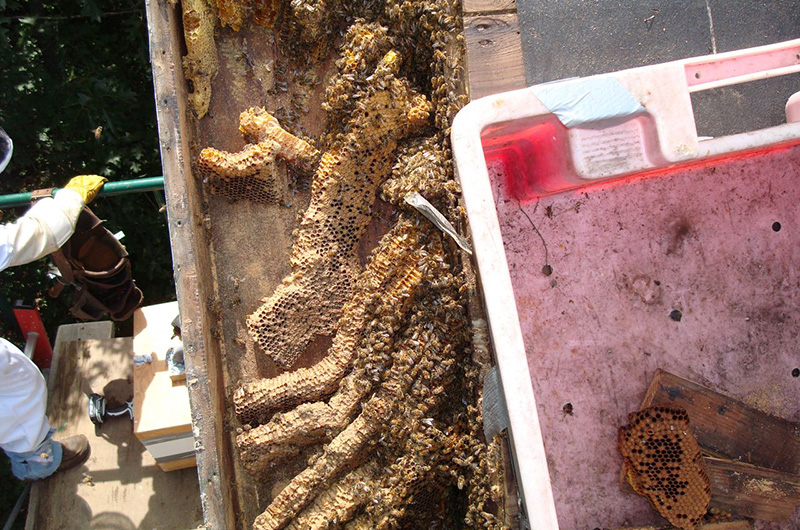About a third of the food we eat is made possible by the cross-pollination of bees. But when you’ve got a huge hive within the walls of your house, your ecological conscience may only stretch so far.
The old-school way of dealing with a bee infestation is extermination: Call a pest control service and they’ll come out five or ten times and gas them. Honeybees deserve better. Not to mention the fact that there are far more efficient ways of dealing with the issue.
Russ Hartenstine is the senior manager for Pyramid Property Management in Vineyard Haven, and over the past several years he has developed a technique for bee extraction and hive reclamation that is both humane and effective.
“Exterminators often don’t like to remove bees,” Russ explains, “because they can’t kill the hive in one shot. It’s also hard to get access to the hive – you often have to use staging to open up walls to get to them. And unless you remove the hive, the larvae will hatch and continue to create issues for the homeowner, like attracting rodents.”
Russ has experimented with different techniques, including smoking out bees, which, while more humane than gassing, still is not that efficient.
“I used to smoke bees,” Russ explains, “but the problem was that it would take several times because the bees would keep returning. I finally realized that rather than drive them away, it was better to keep them in a confined area and then vacuum them up as quickly as possible.”
Initially Russ rigged up a standard shop vacuum with a plywood holding cage to capture the bees, but the problem was that the shop vac was too powerful and it killed more bees than it saved. Russ now uses a much smaller, two-horsepower vacuum. The vacuum is mounted on top of a five-gallon drywall bucket and inside that bucket is a wire mesh cage to hold the bees. A hose runs from the bucket out to the site of the hive and gently draws the bees inside. When the wire cage is full, he secures the top and removes it from the bucket and inserts another mesh cage.
“There’s an amazing sense of calm that I feel when I’ve just opened up the wall of a house and suddenly there are a hundred thousand bees swirling around my head,” explains Russ. “You would think they would just be out attacking you, but they’re actually just looking around and then they go right back into the hive and they immediately start sucking up the honey resources they’ve been saving and then fly away as quickly as possible. The bees are actually pacifists – they’re amazingly adept at working with the world around them. Sometimes I wish humans were more like bees.”
Once he has extracted the bees, Russ quickly delivers them and their honeycombs to various beekeepers on the Island so they can rebuild the hive in a more appropriate place. He estimates that this reclamation technique is successful about 30 to 50 percent of the time.
Right now Russ has pretty much cornered the market on live bee extraction on the Island but he’s not in it just for the business. Colony collapse disorder has dramatically reduced the number of honeybees nationwide, and it’s no different here on the Island.
“I look at this as not only a service to the client,” explains Russ, “but as a way to try to help farmers on the Island and the environment as a whole.”





